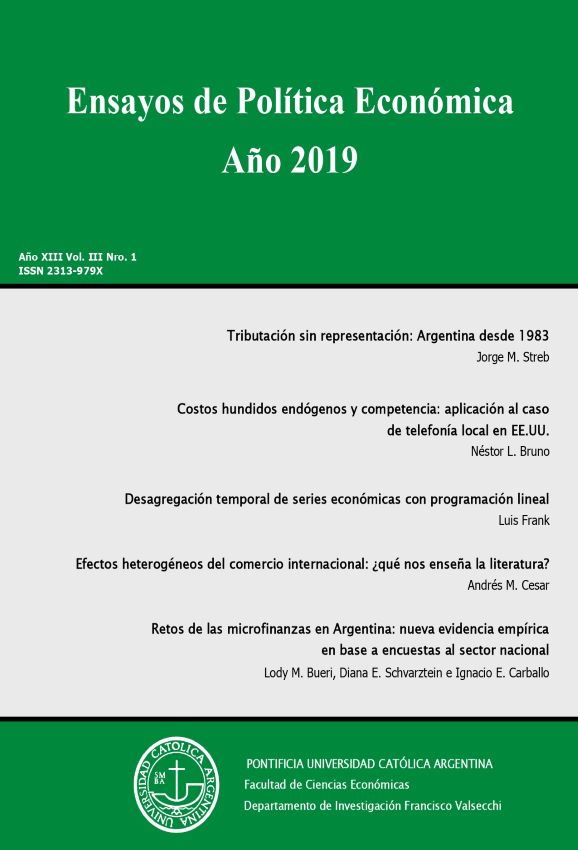Endogenous sunk costs and competition: application to the case of local telephony in the US
Keywords:
sunk costs, competition, telecommunicationsAbstract
One of the first international cases of telecommunication regulation that sought that incumbent firms shared their economies of scope and their network economies with their competitors was the one that took place in the United States, through the so-called “Telecomm Act” (1996) and its corresponding implementation through the Federal Communications Commission (FCC) in that country. The paradigm behind that scheme is the belief that reduction in entry barriers can imply an increase in market entry, since competitors that do not have to sink costs in building new networks can be able to compete to gain market share. Once those competitors obtain that market share, therefore, they will be able to build their own networks, and hence they will increase market capacity and change market structure. This paper seeks to reconcile the empirical evidence about the project implemented by the FCC with a conceptual model of competition in telecommunications with is different from the one pursued by the US regulator between 1996 and 2005. It is shown that industry concentration stays high despite the introduction of competition in the incumbent’s network, due to the existence of endogenous sunk costs within the industry.Downloads
References
Bain, J. (1956). Barriers to new competition, Cambridge: Harvard University Press.
Baumol, W., Panzar, J. y Willig, R. (1982). Contestable markets and the theory of industry structure, Nueva York: Harcourt Brace.
Coloma, G. (2005). Economía de La Organización Industrial, Buenos Aires: Temas Grupo Editorial.
Dippon, C y Ware, H. (2010). “Wholesale Unbundling and Intermodal Competition”, Telecommunications Policy Journal 34, 54–64.
Federal Communications Commission (FCC) (2003). FCC Adopts News Rules for Network Unbundling Obligations of Incumbent Local Phone Carriers, February 20.
Federal Communications Commission (FCC) (2004a). Statistics of Common Carriers, October 2004.
Federal Communications Commission (FCC) (2004b). Trends in Telecomm Services, October 2004.
Federal Communications Commission (FCC) (2005). Report and Order and Notice of Proposed Rulemaking, CC Docket Nos. 02-33, 01-337, 95-20, 98-10, WC Docket Nos. 04-242, 05-271 (rel. Sept. 23, 2005), Appropriate Framework for Broadband Access to the Internet over Wireline Facilities, (classifying wireline broadband Internet access service as an information service), Released September 23.
Fisher, R. A., y Tippet, L. J. C. (1928).” Limiting forms of the frequency distribution of the largest or smallest member of a sample”. Mathematical Proceedings of the Cambridge Philosophical Society, 24 (2), 180–190.
Friedman, J. (1971). “A non-cooperative equilibrium for supergames”. The Review of Economic Studies, 38 (1), 1-12.
Friedman, J. (1977). Oligopoly and the theory of games, Amsterdam; North-Holland.
Giorgetti, M.L. (2003). “Lower Bound Estimation – Quantile regression and simplex method: an application to Italian manufacturing sectors”, The Journal of Industrial Economics, 51 (1), 113-120.
Gumbel, E. J. (1958). Statistics of extremes, New York: Columbia University Press.
Hausman, J. & Sidak, J. (2004). “Did mandatory unbundling achieve its purpose? Empirical evidence from five countries”. Working Paper 04-40. Cambridge, MA: MIT Department of Economics.
Hazlett, T., & Caliskan, A. (2008). “Natural experiments in US Broadband Regulation”. Law and Economics Research Paper Series, 08-04. Washington, DC: George Mason University.
Koenker, Ng y Portnoi (1994). “Quantile Smoothing Splines”, Biometrika, 81,673-680.
Kreps D. y Scheinkman J. "Quantity precommitment and Bertrand competiton yield Cournot outcomes", Bell Journal of Economics, 14, 326-337.
Organization for Economic Co-operation and Development (OECD) (2006). Policy Roundtables: Access to Key Transport Facilities.
Robinson, W. y Chiang, J. (1996). "Are Sutton´s predictions Robust", The Journal of Industrial Economics, 44, 389-408.
Smith, R.L. (1985). "Maximum Likelihood Estimators in a class of nonregular estimators", Biometrika, 72, 68-90.
Smith, R.L. (1994). "Nonregular regressions", Biometrika, 81, 173-183.
Smith, R.L. (1998). "Forecasting Records by Maximum Likelihood", Biometrika, 83, 331-338.
Sutton, J. (1991). Sunk Costs and Market Structure, Cambridge: The MIT Press.
Tirole, J. (1988). The theory of Industrial Organization, Cambridge: The MIT Press.
Train, K. (1995). Optimal Regulation: The Economic Theory of Natural Monopoly, Cambridge: The MIT Press.
Watersson, M. (1984). Economic Theory of the Industry, Cambridge: Cambridge UniversityPress
Downloads
Published
How to Cite
Issue
Section
License







 Ensayos de Política Económica
Ensayos de Política Económica